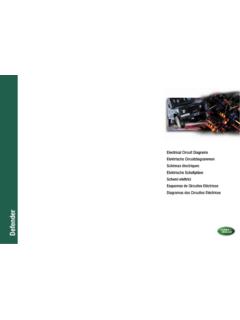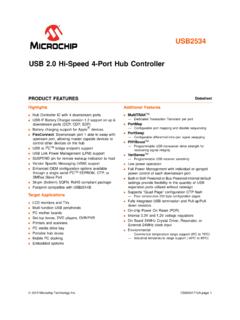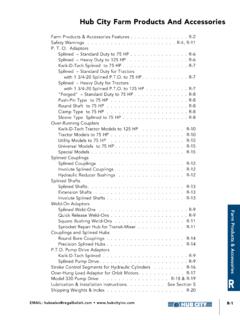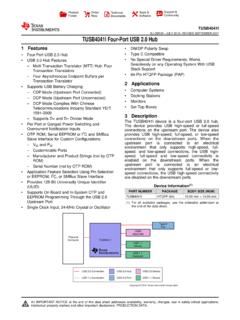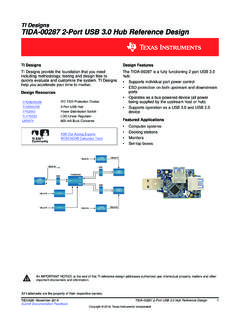Transcription of Replacing the hub oil seal - Ventas Legión Land Rover
1 Replacing the hub oil seal . The most common reason for hub oil seal failure is a blocked axle breather, so check this first before you start. Remove the brass bell-shaped fitting on the top of the axle, and give it a shake. There is a ball bearing in there, which will rattle if the breather is not completely blocked with dirt, if it does rattle, try blowing through the breather, as sometimes the outer part can be blocked with dirt, even if the ball bearing rattles inside. It is possible to clean them out with a bit of wire and some petrol, or WD40, though. It just needs a bit of patience! Once it is clean, replace the breather back on the axle, and turn your attention to the hub that is leaking. You can usually tell when the hub oil seal has failed, as oil will be leaking out of the brake drum, probably onto the tyre on the inside of the wheel. First remove the road-wheel and support the Landy on axle stands (do I need to remind you about that still?)
2 ? Squished folk don t get driving Landies!). Now remove the 6 bolts and spring washers holding the drive flange in place, and, if working on the rear axle, then remove the drive flange and halfshaft complete. If you are working on the front axle, then you will need to remove the top hat , or FWH if fitted (see article about swivel Here ) and undo the nut and split-pin holding the halfshaft in place, before you can remove the drive flange. This next photo shows the drive flange removed, it is a front axle, so the half shaft is still in place. Now undo the three screws holding the brake drum in place, and pull off the drum. Don t forget to back off the brake adjusters first! Sometimes, the drum can prove to be awkward to remove, as in this circumstance, and as the hub is being removed anyway, you can remove the hub and brake drum together, and remove the drum once the unit is on the workbench. To remove the hub, bend back the locking tab holding the outer locknut in place, and then undo the nut.
3 You will need to use a hub-nut box spanner for this. You can then simply remove the lock tab, and undo the inner adjusting nut. In the next photo you can see the nuts have been removed, and the thrust washer is visible. So now time to remove the hub and drum (if still fitted) and start to inspect the components. This next photo shows the front hub components as fitted to a SI. The only thing missing in the photo is the felt washer, but according to the parts book, there isn t one! The inner bearing is still in the hub at this stage. A quick look now at the new bits you will need. This next photo shows the original type of seal fitted to the hubs on early Landies, the lips of the seal are made of leather! To the right of this seal are the felt washers you will need on all axles up to 1980. They are fitted with the neoprene side facing inwards. Now a quick look at the next type of seal , as fitted to Landies up to 1980, it is made of neoprene, and the top one on the photo is showing the inside of the seal .
4 Now a look at the later type of seal , as fitted to axles made after 1980, again, the top seal is showing the inside ( facing the inner bearing) By far the easiest way to buy the parts you will need is to get a kit of bearings and seals, which at 2005 prices cost around 15 per hub, and include everything you need to replace the bearings in the hub, and the seals and gaskets. Here s a look at what comes in the kit for the later type of paper drive flange to hub gasket is not visible in this photo. Back to the hub oil seal by levering it out using a pry-bar, or a big screwdriver. Remove the inner bearing and clean all the components carefully. Inspect the bearings and race very carefully, any sign of scoring, or wear on the tracks; or any signs of grittiness when the bearings are run on the races, then the bearings must be replaced. If one is okay, and the other isn t, replace them both. Replacing just one is false economy. To do this, drive the old races out using a hammer and a drift.
5 Now, once the OLD races are out, take the OLD races to the grinder, and grind right round the outside edges of the races so that they will fit into the hub without sticking. The old races are the ideal tool to use when driving the new races in evenly. Tap the new ones in slowly, carefully and evenly, until they are fully home. Pack the inner bearing with grease. To do this, put a blob of High Melting Point grease into the palm of your hand (your missus is going to love you for this) and press the grease through the bearing, until it comes out of the other side of the rollers. Messy, but fun! Insert the bearing into the race, and fit the hub oil seal . The lips of the seal should face the bearing. Now carefully and evenly press it home until it is flush with the edge of the hub. You might use a big socket or similar for this, but it is important that the seal goes in evenly, and the lips are not damaged. The later type of seal , with two lips, as fitted to 1980 onwards axles should fit so that the outer of the lips is about 1mm below the hub casing.
6 It has a lip on the outer edge of the seal too, and this should end up flush with the hub casing. Pack the hub with fresh grease, (some people use swivel grease in here too) and then grease the outer bearing. The hub is now ready to refit. Before refitting the hub, check the stub axle for signs of wear. If your Landy has an early type of axle, (pre 1980), then the stub axle has a replaceable land or distance piece. The above photo s show a stub axle from an earlier axle, before and after removing the land , if the land is scored or worn as in the next photo, it will need to be removed and replaced with a new one. No need to remove the stub axle though (the one in the photo was removed as part of a full axle rebuild) as you can remove the land by first cutting into it a bit with a hacksaw, and then driving a sharp cold chisel into the slot you cut. This will split the land, and it will come off easily. Once it is off, it is a simple matter of pressing the new land onto the stub is a tight interference fit.
7 Sorry to tell you though, that the later type of axle does not have a replaceable land on the stub axle, so if that is worn, you will need a new stub axle I m afraid. Now time to refit the hub and the outer bearing into position on the stub axle. Oil the lips of the seal first with EP90, as it stops them from running dry at first and saves them from wearing out very rapidly. Fit the thrust washer, and the adjusting nut. Tighten the adjusting nut until there is no free-play or end float in the hub, and then loosen the nut a little. Spin the hub several times to settle the bearings, and repeat the process. The workshop manual recommends that you should use a dial gauge for this, and adjust the end-float to between and , but this can be gauged by feel, with a little practice. There should be a trace of movement/endfloat in the hub. Once you are happy with the end-float, fit the lock-tab/washer, and the locking nut. Tighten the lock nut (check the end float again after doing this) and then bend the tabs over on the locking washer as in the next photo.
8 Then replace the drive flange and halfshaft. Use a new paper gasket between the hub and drive flange. Replace the brake drum, fit the three retaining screws and tighten them up hand tight. The tap the drum to the hub with a mallet, and tighten the screws again. It is important to do this, as sometimes the drum may not be fully home, and you may end up with a damaged drum, or wheel and wheel studs. Or, worse still, losing the wheel whilst driving along! Adjust the brakes, and then replace the road wheel. Check the brakes again, and the job s done.
